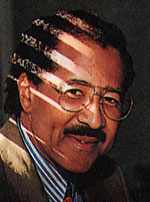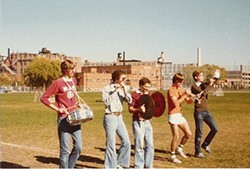Art, Discipline, Beauty, Management—in Football
-
-
slice.mit.edu
- 2
Filed Under
Recommended

In the new issue of the MIT Faculty Newsletter, Professor James H. Williams, Jr. ‘67, SM ‘68 writes about an unusual topic—this year’s fabulous football season in the context of campus culture and personal history. Professor Williams, an accomplished author as well as faculty member in MIT’s mechanical engineering department and writing and humanistic studies program, discusses the art, discipline, beauty, and management of football at MIT. This excerpt is likely to give you a taste for the longer piece titled “A Magical, Almost Perfect, Season.”
If you are a first-year undergraduate and want to study economics, linguistics, literature, political science, urban studies and planning, or writing at MIT, you must nevertheless take—or, perhaps I should say be grateful for the opportunity to take—freshman biology, calculus, chemistry, and physics alongside some of the world's future top engineers, mathematicians, and scientists. There are no “basket-weaving” subject offerings or scholarships for jocks at MIT.
Thus, the task of finding enough students to play competitive intercollegiate football at MIT is immense. Even so, one of the distinctions of the Institute's undergraduate population is that this body of students is also the same pool that has produced the largest number of Division III Academic All-Americans in the history of collegiate athletics. [In fact, my former research student (SB, SM, PhD) in 1979-80 became MIT's first Academic All-American.]
I suggest that anyone who has not visited the MIT Athletics homepage do so. Whatever positive feelings you may already have for our undergraduates, your respect for them will grow after visiting the MIT Athletics homepage. You may also better understand why during my years as a student and faculty member, I have attended hundreds of intercollegiate athletic events involving MIT undergraduates and I competed on dozens of intramural athletic teams (until I broke my leg playing softball for the New West Campus Houses in 1982).
I often write about our undergraduates who need to hear more often how much the faculty and administration enjoy observing their growth and want to support them in achieving their goals. Last month, I was chatting in the corridor—where many, if not most, important conversations occur at MIT—with a colleague who was so pleased with the dedication and intellectual development of the undergraduates in a demanding disciplinary subject in mechanical engineering. Last year, I wrote the following to a senior administrator, in response to a speech he gave: "In the daily hustle and bustle of MIT, our students' global perspectives, capabilities, and potential impacts can be easily submerged, and occasionally even lost. Thus, daring to positively change the world becomes an important message for them to hear . . . ." Our students are too sophisticated to be enamored with false compliments but, in what is too frequently MIT's no-praise culture, they need to hear the faculty's and administration's applause when they have earned it.

As the first housemaster of New House in the late 1970s, I witnessed several uniquely memorable events in MIT's history.
Throughout weekends during that period, oversized—and I do mean oversized—audio speakers in Burton-Connor and elsewhere along Dorm Row bathed Briggs Field in Chuck Mangione's "Feel So Good."
In 1978, the MIT Football Club was founded and joined the National Club Football Conference, with the team ultimately becoming a varsity program and a member of the NCAA Division III in 1987.
The MIT Marching Band was also formed in 1978. Although I never saw more than six or seven members at any single time, I found them to be musically skillful and cleverly resourceful as I observed them practicing on Briggs Field. The band had no uniforms, and several of its members bristled at The Tech's characterizations that they constituted a "spoof," employed "haphazard formations," and that their sundry shirts, shorts, and bell-bottom jeans were "random costumes." Nevertheless, applying both Gaussian and Lévy distributions, I tried to write a manuscript using statistical analysis to describe the band's marching formations, but my assumption of ergodicity was too constraining.
On Saturday, October 28, 1978, the MIT Football Club played, but lost, its only home game that year. (Actually, the team lost all its games that year.) The game also served as a campus-unifying Homecoming during which the MIT Marching Band performed. Another highlight of that festive day was the appearance of the reigning UMOC (Ugliest Man on Campus) who, as the Homecoming Queen, rode into Henry Steinbrenner Stadium on his "chariot" (a decaying flatbed covered with cardboard, depicting the urging "Go Tech"), waggling his "scepter" (a wooden walking cane), and bedecked in the queen’s pink cape and "crown" (part of a milk carton). I must confess: I adored him then and I have never forgotten him.
In 1978, MIT's student body was at its sui generis best.
Read the full article in the MIT Faculty Newsletter.








Comments
Kak dolop
Mon, 04/27/2015 5:29am
Thank you for allowing me to see a very interesting article like this Footbal MIT. thanks admin.
Walter Crosby
Thu, 03/05/2015 1:01pm
Thanks for letting us know about this writing. As one of the MIT Football Founders, I'm looking forward to reading this!